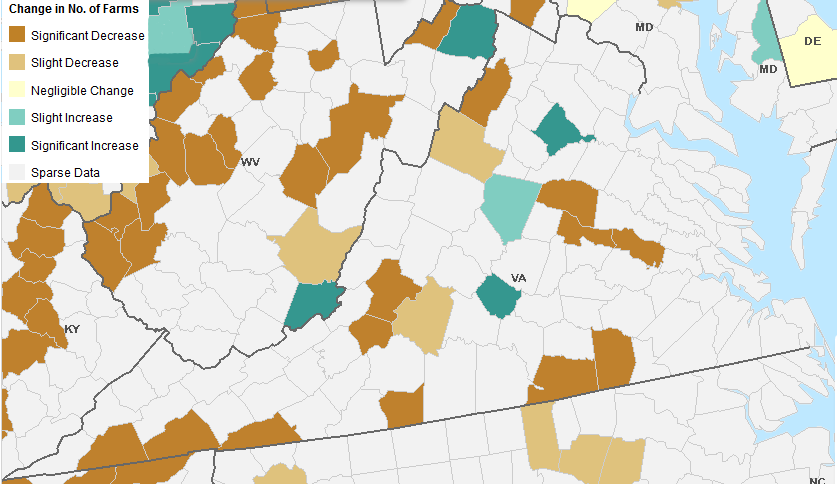
the number of farms in Virginia is decreasing as farmland is converted to residential use or cut up by roads
Source: United States Department of Agriculture, Ag Census Web Maps, Change in Number of Farms: 2007 to 2012

the number of farms in Virginia is decreasing as farmland is converted to residential use or cut up by roads
Source: United States Department of Agriculture, Ag Census Web Maps, Change in Number of Farms: 2007 to 2012
George Washington conducted the first agricultural census in 1791. Every 5 years now, the Federal government conducts the Census of Agriculture, gathering statistics. The cut-off point separating farms that are counted vs. household gardens excluded from the census is clearly defined:1
The census is completed in years that end with a 2 or a 7. In 1997, the US Department of Agriculture assumed responsibility for the agricultural census from the Bureau of Census. The National Agricultural Statistics Service (NASS) and the state Department of Agriculture and Consumer Services both publish information about farm production in Virginia.
Today, relatively few Virginians have ever worked on a farm. More Virginians plant tomatoes and flowers in suburban gardens than earn a living from raising food or fiber on a commercial basis.
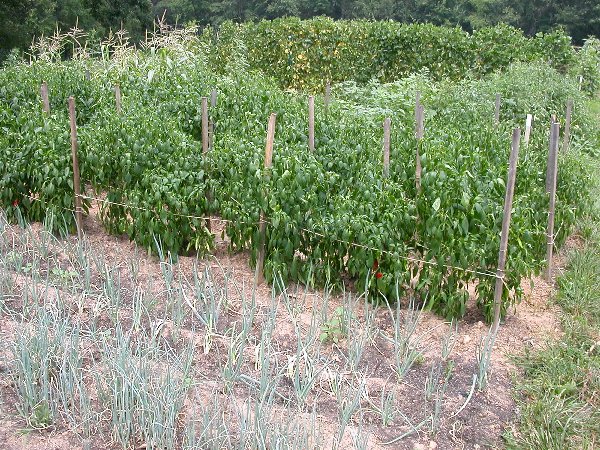
Urban Garden in Fairfax County
Farmers near urban centers are able to supplement their income via "agri-tainment" (such as corn mazes and music festivals at U-Pick orchards) because urban residents consider it an unusual experience to visit a farm. Suburban gardeners still get a personal intellectual and emotional connection to the soil and experience the vagaries of the weather - but when there's a late frost, an August hailstorm, or an early freeze, Virginia farmers suffer a substantial economic loss as well.

hayfield in Louisa County
Virginia had 41,095 farms in 1997, down over 2% from the 42,222 farms in 1992. The last dairy farm in Arlington County ceased operations in 1955.2
Nationwide, 19 other states had more farms than Virginia. Kentucky had twice as many farms compared to Virginia, and Tennessee had nearly the same number as Kentucky. North Carolina also had more farms than Virginia. (The census identified 1.9 million places nationwide that should have produced or sold $1,000 or more of agricultural products in 1997.)
Within the state, Rockingham County had 1,834 farms, making it #1 in Virginia and #56 in the country. Washington County was #2 in Virginia, with 1,744 farms. While Rockingham lost only 30 farms since 1992, Washington County lost 242 farms and dropped from #38 to #72 in national rank over those 5 years.
About half of Virginia is "rural." In 1982, Virginia had 3,397,600 acres of cropland. Table 2 in the 1997 National Resources Inventory identified the "land cover/use of nonfederal rural land" in Virginia:
| Year | Cropland (in thousands) | CRP land | Pastureland | Rangeland | Forest land | Other rural land | Total rural land |
| 1982 | 3,397.6 | 0.0 | 3,249.6 | 0.0 | 13,455.8 | 617.8 | 20,720.8 |
| 1987 | 3,109.8 | 23.2 | 3,222.3 | 0.0 | 13,511.4 | 594.6 | 20,461.3 |
| 1992 | 2,901.5 | 74.0 | 3,206.9 | 0.0 | 13,460.7 | 588.1 | 20,231.2 |
| 1997 | 2,917.5 | 70.7 | 2,995.3 | 0.0 | 13,315.8 | 586.7 | 19,886.0 |
The Conservation Reserve Program (CRP) is taking some marginal cropland out of production, reducing supply of some commodities and stabilizing or increasing the price for such crops. The main benefit, however, is the reduction of sediment and nutrients washing off poor farmland and degrading the water quality in nearby streams. The Commonwealth of Virginia supplements the Federal program with a state-sponsored Conservation Reserve Enhancement program (CREP), which is an essential part of the strategy to "save the bay."
In addition, Ducks Unlimited adds an additional supplement for environmental conservation projects such as fencing cattle out of streams. Farmers may not have to invest any of their capital to construct such systems, but they have to modify farm operations and maintain the facilities.
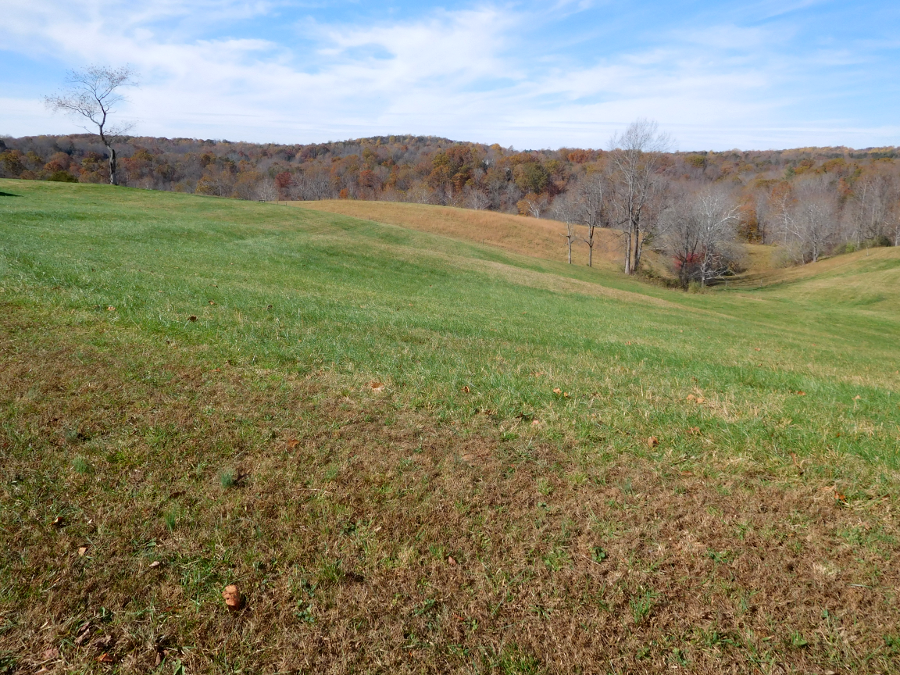
pasture in Fauquier County
The number of acres used for forest land in Virginia changed little in those 15 years. However, 480,000 fewer acres were dedicated to growing crops (corn, wheat, etc.) in the 15 years between 1982 and 1997. That's a 14% decline. Over 250,000 fewer acres were used as pastureland, a decline of nearly 8%. 70,000 acres were set aside in the Conservation Reserve Program, but the land use changed substantially for over 660,000 acres in Virginia in those 15 years.
Over 830,000 acres (shown in last column) were converted from rural to urban/suburban use. The state's population grew 32% between 1980 and 2000, increasing from 5.3 to 7 million people in 20 years. The sprawl of housing developments and roads further into the countryside changed the landscape of Virginia.
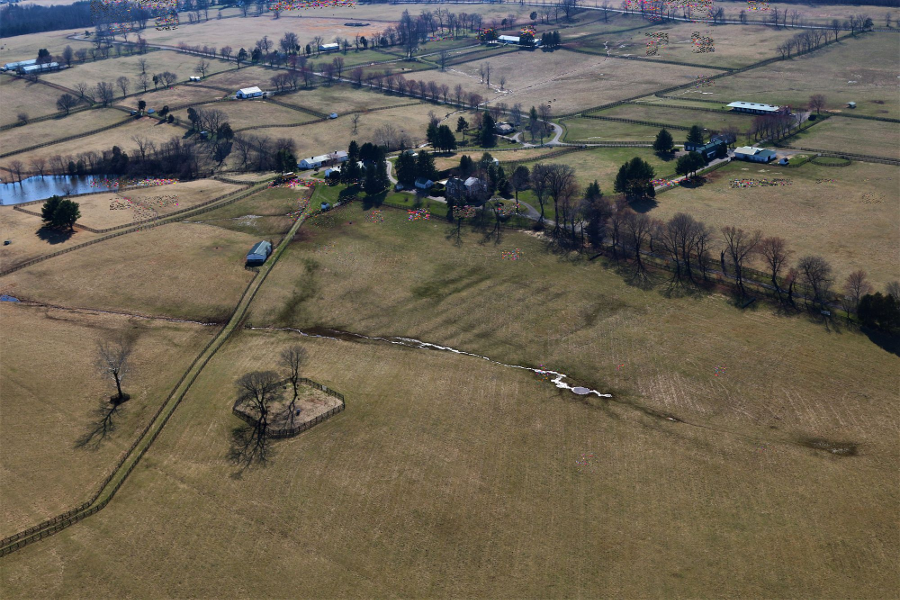
Buckland Farm in Prince William County was subdivided into 10-acre residential lots in 2019
Source: Historic Prince William, Buckland Farm - #269
This land use conversion has been underway ever since mechanization and fertilization improvements have allowed farmers to achieve higher yields (more bushels per acre, more milk per cow, more white meat per chicken...) with less land and labor.
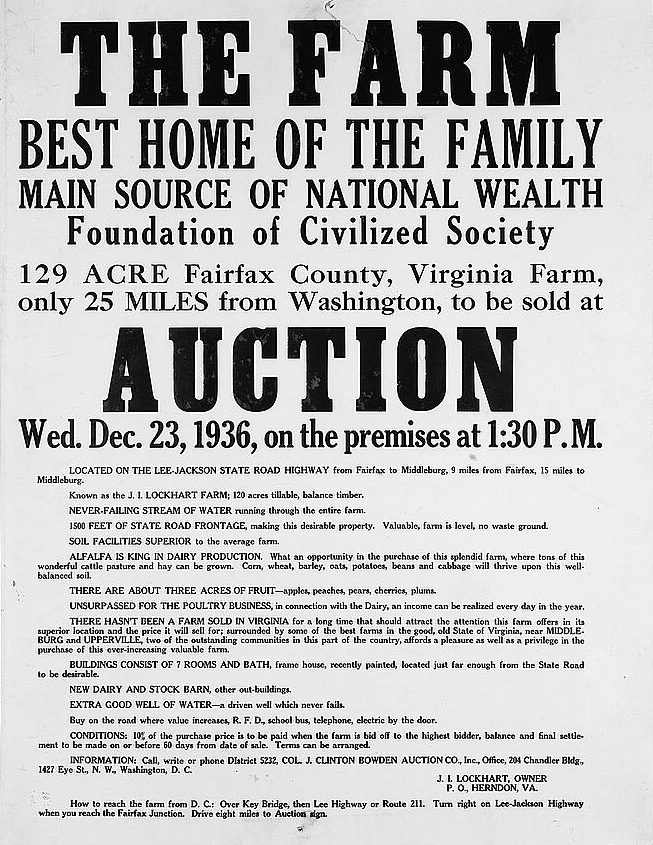
Fairfax farms were sold in the Great Depression
Source: Library of Congress, Handbill distributed around Herndon, Virginia
Transportation improvements have also been a major factor - the Culpeper-Rappahannock Cooperative mill in Culpeper depends upon wheat shipped from the Northern Neck and corn from the Midwest, rather than just crops harvested locally. Appraisers determine the value of property based on its highest and best use, and farmland in Stafford and Fluvanna counties is often valued on its potential to become a subdivision rather than the potential profits from using the acreage to grow hay or corn.
The "Acres of 1982 Prime Farmland Converted to Developed Land in 1997" shows the pattern was true for most of the United States east of the Mississippi River, except for Florida, Appalachia, the northern half of Michigan, and the far Northeast. Nationwide, in the 5 years between 1992 and 1997, the number of farms dropped less than 1%.3
The pattern of farming changed substantially, however. The tiny "Farms With Sales of Less Than $2,500" (where the owners obviously were not full-time farmers, but relied upon a regular job or other outside source of income) increased over 17%. All categories of farms with sales between $2,500 to $249,999 declined, but farms with sales greater than $250,000 all increased. The statistics show clearly that, nationwide, agricultural production is continuing to shift from the small family farm to the larger corporate farm.
One reflection of the decline in small farms is the difficulty of finding a USDA-inspected slaughterhouse for processing locally-grown pigs and cattle. Small agricultural operations rely upon independent butcher shops, so the meat can be sold in commercial markets to the general public. In Harrisonburg, local farmers (including Joel Salatin of Polyface Farms) purchased the T&E Meat Market in 2007, facilitating the continued operation of small-scale ranches in the Shenandoah Valley.
In southeastern Virginia, the only remaining farmer who still raised hogs from piglet to maturity in Isle of Wight County in 2014 had to transport his mature pigs to a slaughterhouse 140 miles away. The Newport News Daily Press noted that the economies of scale in industrial-sized operations had altered the agricultural landscape, and the only competitor in the county for giant corporation Smithfield Foods grew only 12 hogs at a time:4
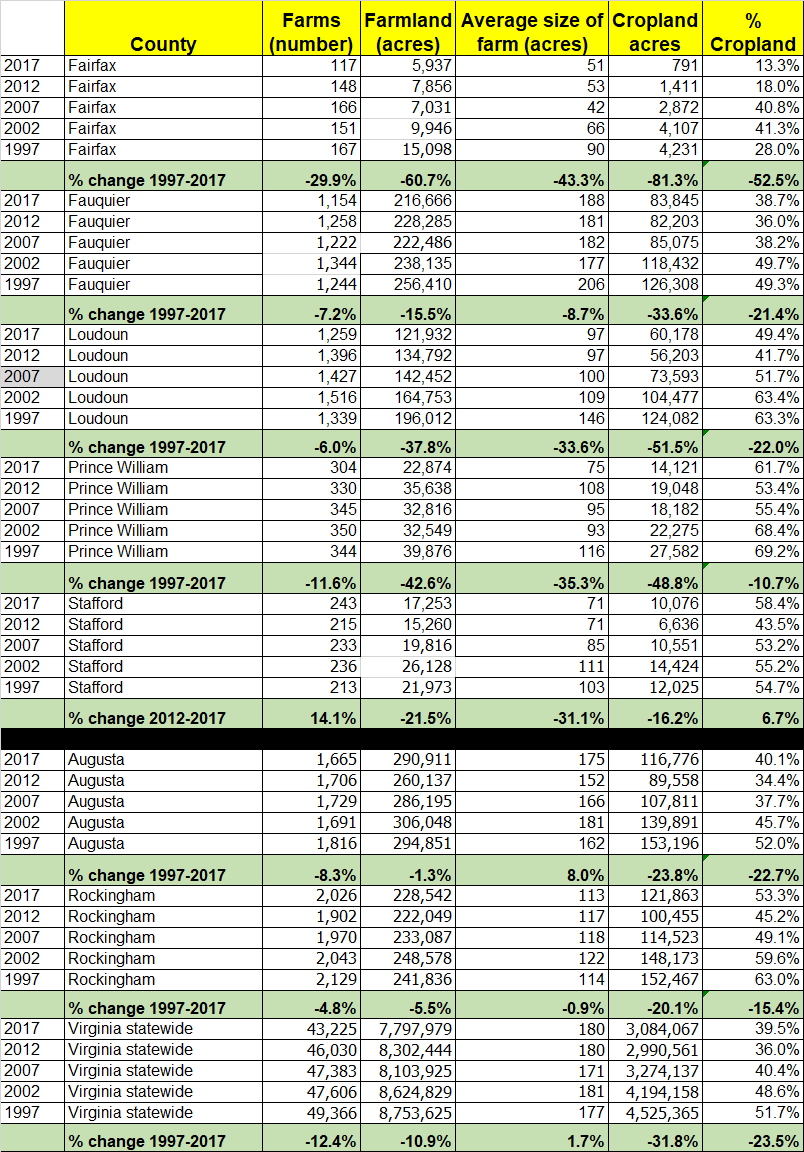
acres of farmland in Northern Virginia dropped dramatically in 20 years, in contrast to farmland loss in the Shenandoah Valley's top two agricultural counties
Source: National Agricultural Statistics Service (NASS), 2017 Census of Agriculture (Chapter 2, Table 1 - County Summary Highlights)
An attempt to open an independent slaughterhouse in Halifax County failed in 2022. The two local men who proposed the facility recognized a business opportunity. Large slaughterhouses were requiring cattle farmers to make appointments a year in advance, and the nearest small slaughterhouse was in Pittsylvania County.
Local community opposition blocked the project. It would have been located in the African-American community of Sinai, which was not the home of people who owned local farms. As one resident noted:5
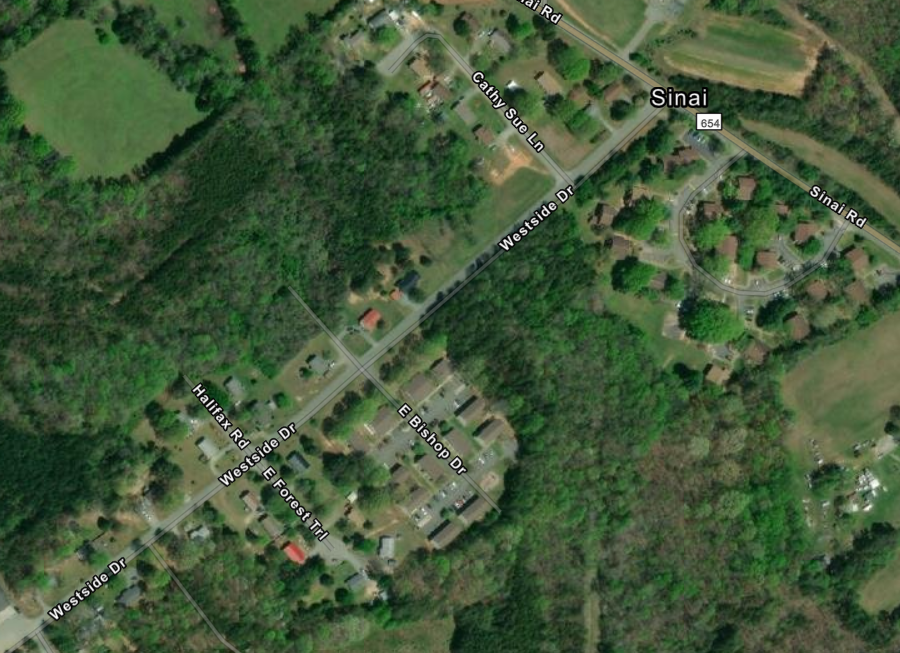
residents blocked construction of a slaughterhouse in the community of Sinai (Halifax County)
Source: ESRI, ArcGIS Online
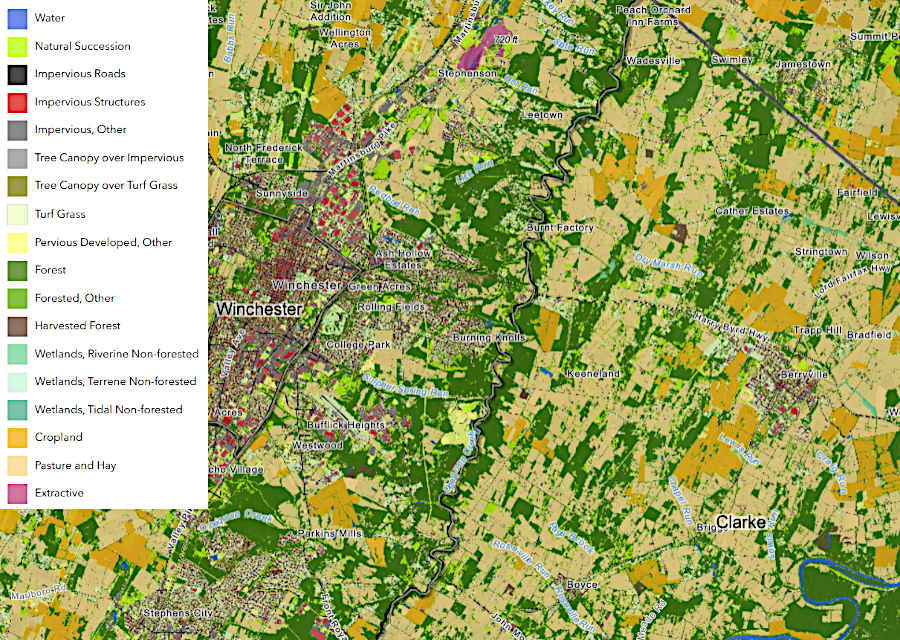
expanding development around Winchester reduces acreage of farmland in the lower Shenandoah Valley
Source: Chesapeake Bay Program, CBP Data Project LULC and Hydrography Viewer